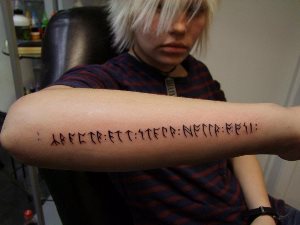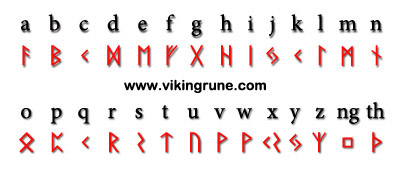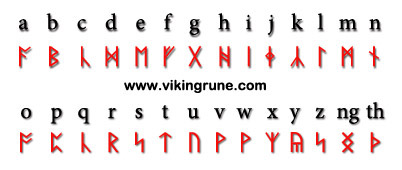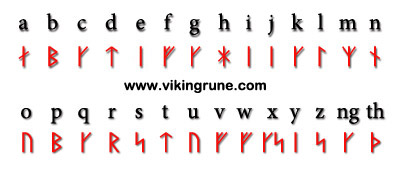 Developing a great design for a tattoo is critical in case you seriously plan to get inked. If you are about to have a Norse or Viking tattoo, I bet you want to include some Nordic runes into it. Tattooed inscriptions in foreign languages or written in unusual characters may well be a source of trouble, especially if you don’t know well the language or the writing system. Online translation tools may play a trick on you: a woman who wanted to have “I love David” in Hebrew on her back, later realized the actual tattoo said “Babylon is the world’s leading dictionary and translation software”. David Beckham inked his wife’s name on his left forearm in Hindi but misspelt it. The tattoo read Vihctoria instead of Victoria with additional h. The name is well known in India because of Queen Victoria, so the person who developed the tattoo design probably wasn’t a native Hindi speaker and even did not know the language well. Perhaps you wouldn’t like to be in such a situation with your runic inscription, would you?
Developing a great design for a tattoo is critical in case you seriously plan to get inked. If you are about to have a Norse or Viking tattoo, I bet you want to include some Nordic runes into it. Tattooed inscriptions in foreign languages or written in unusual characters may well be a source of trouble, especially if you don’t know well the language or the writing system. Online translation tools may play a trick on you: a woman who wanted to have “I love David” in Hebrew on her back, later realized the actual tattoo said “Babylon is the world’s leading dictionary and translation software”. David Beckham inked his wife’s name on his left forearm in Hindi but misspelt it. The tattoo read Vihctoria instead of Victoria with additional h. The name is well known in India because of Queen Victoria, so the person who developed the tattoo design probably wasn’t a native Hindi speaker and even did not know the language well. Perhaps you wouldn’t like to be in such a situation with your runic inscription, would you?
Many runic tattoo designs include a name. You may want to have inked in runes the name of a beloved one, your own name, or a name of a deceased person who was important in your life. Now if we are to spell it in the Elder Futhark runes, we have to look deeper into what spelling is and have a look at the following facts:
-
The ideal alphabet has a separate symbol (letter or rune) for each sound the language has.
-
The Elder Futhark runic alphabet was such an ideal system: there are as many Elder Futhark runes as there were sounds in the Proto-Norse language, for which they were developed.
-
Roman letters used to transcribe the English language today do not constitute an ideal alphabet. Several sounds (have a look at the IPA chart of English) do not have letters of their own. They are transcribed with letters or combinations of letters used for other sounds as in ch for [tʃ] and sh for [ʃ].
-
The Phonological system (sound system) of the Proto-Norse language was not the same as in modern English. It had sounds that do not exist in English. It also did not have some sounds that do exist in English: for instance English has the sounds [tʃ] [dʒ] [ʃ] [ʒ], whereas Proto-Norse did not have them.
-
If we try to use the Elder Futhark runes phonetically, that is substituting runes for the sounds we hear, the way runes were supposed to be used, we will fail, because there are not enough runes for all the English sounds.
So the solution is to keep modern English spelling. It is true that ancient rune carvers did not use it. However, it is also true that they did not have to transcribe words containing sounds like [tʃ] [dʒ] [ʃ] [ʒ]. Should they have to, they would invent a way to do so. Not necessarily combining s and h for [ʃ] as in ‘shame’ or c and h for [tʃ] as in ‘child’. May be they would even invent something more logical than using as many as three variants for one and the same sound [dʒ] as in ‘gin’, ‘joy’, and ‘edge’.
Even though keeping the English orthography eliminates the most of the problems, some still remain. First, there are 26 Roman letters in the English alphabet and only 24 runes in the Elder Futhark. Second, not all of the runes have obvious counterparts in Roman letters, for instance the *eihwaz rune denoted a phoneme with the sound value between [i] and [e]. Since we have *isa and *ehwaz for English i and e, *eihwaz remains unemplyed. Below is a table of letters and their runic counterparts, showing how all this can be resolved:

Note that this way to collate letters and runes is not canonical. It is based on my own understanding of phonology and orthography. No one has ever decreed ex cathedra that such a set of counterparts—fixed as the ‘right’ or ‘correct’ one—should at all exist. There has been no social contract concluded to this effect, either. An algorithm based on this table is behind the rune converter that I developed. You may see other tables of counterparts on the Internet that suggest different solutions. Keep in mind that you may also find phonetic explanations of runes, which were not compiled as a help for those who want to write a name in runic symbols. In such cases as my earlier post the counterparts denote the letters used to transcribe ancient runic inscriptions. Here is also the table for the Anglo-Saxon runes known as the Anglo-Saxon Futhorc:

The Younger Futhark runic alphabet has only 16 runes. It uses one and the same rune for such pairs as [p] and [b], [t] and [d], [k] and [g]. So such names as ‘Tina’ and ‘Dina’ will look the same in these runes. The words ‘Pat’, ‘pad’, ‘bat’ and ‘bad’ will be identical as well. So before any permanent use I would strongly advise to check for all possible readings of the resulting Younger Futhark rune sequence. If the name can be read as some other word as well, you’d better know it before you get a tattoo. For example, the word ‘big’ may be read ‘pig’ as well, which may turn as a rather unpleasant surprise. Since the same rune is used for both [i] and [e], the same word in runes may also be read as ‘beg’ and ‘peg’. Note that there is only one rune for [u] and [o], too. The table for the Younger Futhark runes is as follows:

The appearance of runes in the charts above is not the only possible one. There have been many variants of runes depending on geographical area and historical period. For instance, beside the so called long branch Younger Futhark, pictured above, there was a short twig variant as well. Later it was transformed into the so called medieval runes.
Note that the principles set up in this article are apllicable not only to names, but to any word, phrase or text in English as well (however, not to Old Norse texts).
See also:
A Guide to Writing in Norse Runes
How to Translate into Runes Correctly
How to Write an Authentic Runic Inscription
Should I Write in Runes Phonetically?
Photo courtesy © NirvanaOfTime

Hello, Im pretty big into the viking scene. Have a group of buddies that get together once a week and we drink mead from all over the place in our mead horns. Just curious on how Hobson would come out in the Norse alphabet.
Thanks
Hello Chris. You may want to use our free online rune converter for that.
I was wandering what my name would be. Looking to get it tattooed but want to make sure it’s right. My name is tjark, I didn’t know if the tj would have some special way of being spelled or if my name is actually straight forward. Thanks for your help.
Straight forward, Tjark.
I wanted to get the word wolf but instead of it all being spelled out I was wondering if it could be overlapped?
Grace, Old Norse for wolf is úlfr.
Hello my name is Michael I want to get my lovers name on me in Norwegian runes so that would be younger futhark right? Her name is Aurora Jade Finkle can anyone help me please?
Hello Michael. Yes, it would be Younger Futhark runes, either long branch or short twig variant.
Hello, I have a great passion for norse mythology. I wanted to get a tattoo of the god Thor’s name in norse ruins. I am not sure if I am correct. Please send me the best suggestion! thank you.
Great, that’s just what I needed too! Thor in runes!
Hi, so my name: Björn, I would just love to get a clear answer as to what is the Original way the name is written
thanks :]
Björn, follow this tutorial: How to Write in Old Norse With Runes.
help please. I am geting tattoo of my daughter name and and i cant find how to write correct. Name is ANJA
Our rune converter will help.
Needing help. I feel like I did it right but before I get it printed I want to make sure I get it right. I’m looking for RAGNAROKKR and yes I mean this not Ragnarok I keep being asked that question. in both elder and younger furthark Please help
Cole, you can do it with our rune converter.
Hello,
I need help on word order. I know runes can be used to directly translate letters but I want to make sure the original norse is correct. What would you translate this into:
Vera hvatvetna ae
In Younger Futhark
Please and thankyou!
Sarah, you may want to follow this tutorial: How to Write in Old Norse With Runes.
this site is awsome and is helping make some thing hidden clear thanks from Makahla Justyce and Nate : )
Thank you.